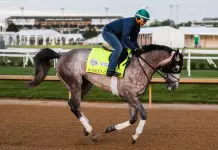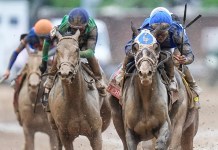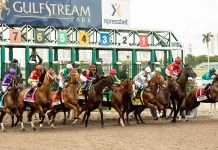Las Vegas
Aside from being favorites that won the Kentucky Derby, what do Justify, Always Dreaming, American Pharoah and California Chrome have in common?
Does the alphanumeric “E/P 7” ring a bell? If anything it should turn on a light bulb for horseplayers charting a betting course the next 15 days for this year’s Derby.
Favorites have won each of the past six years. It is no coincidence that six years ago Churchill Downs started filling the Derby field using a point system and a specific set of prep stakes, none less than a mile. Gone are the days when graded-stakes dollars determined the 20 horses. The new system eliminates the ringers that would use lucrative sprint races to crash the 1¼-mile party.
No wonder, then, that Derby winners now fit a particular mold. They are pace chasers – or, in the language of the Quirin Speed Points, “E/P”s. And mostly “E/P 7”s.
All right, enough with the letters and the virgules and the numbers. Anyone already familiar with the Quirins should just skip past the upcoming, four-paragraph initiation.
Dr. Bill Quirin began writing about modern handicapping techniques in 1979, applying what we would now call analytics to quantify the pace patterns of racehorses. This eventually led to his assigning them an alphanumeric combination based on their past performances.
The letters are at first confusing. “E” = early, “E/P” = early presser, “P” = presser and “S” = sustainer. They are all based on where horses are at the second call; that would be a half-mile into a Derby prep. Now forget all those words. While Quirinistas may scoff, it is better to remember that “E” = early speed, “E/P” = pace chaser, “P” = mid-pack and “S” = closer.
The numbers are more straightforward. They go from 0 to 8 and represent where a horse is likely to be a quarter-mile into the race. The “7”s and “8”s are usually on the lead, the “5”s and “6”s close to it, and so forth going back to “0” for the deep closers.
Why the good Dr. Quirin decided to put the first part of the race second and the second part of the race first – or why he concocted an equine orthodontic-sounding term like “sustainer” – might require me to actually get out of my recliner and crack open one of his books, but I digress.
Let me get back to how all this applies to the Derby. As I pointed out in this column about seven months ago, the only horse in the first six years of the points era to show the best early speed and still hit the board was Dortmund in 2015, when he finished third to American Pharoah. Sure enough, since 2013, he is the only “E” horse to finish in the top five of any Derby.
Sample the six years right before the advent of the points system. While no speed horses led from gate to wire, they were more prominent at the end of the Derby than they have been lately. Bodemeister (E 8) was second to I’ll Have Another in 2012, Shackleford (E 6) fourth to Animal Kingdom in 2011 and Hard Spun (E 6) second to Street Sense in 2007.
Yes, the first year of the points system produced a mid-pack winner. But Orb (P 2) took advantage of a pace meltdown brought on when Palace Malice (P 3), usually a mid-pack horse himself, wore blinkers for the first time when Todd Pletcher turned the Derby into a prep for the Belmont Stakes. On a sloppy track Palace Malice set a three-quarter-mile pace of 1:09.80. They have not gone faster than 1:11.01 since. That is a difference of six lengths.
The last five years it has been all about the “E/P”s. Pace chasers have not only won the last five runnings of the Derby, they have finished second once and third three times. Value hunters may hunt for exceptions that hit the board even if they do not finish first. Lookin At Lee (S 0) finished second two years ago, paying $26.60 to place and $15.20 to show. Commanding Curve (P 1) was second in 2014, paying $31.80 and $15.40.
Granted, five or six years do not make for an enormous sample against the history of a race that has been going on since 1875. But passing the pattern off as coincidence is foolhardy. There are, after all, 10 “E/P”s among the 20 horses currently in position to start May 4. There are only four mid-pack “P”s, four closing “S”s and one horse – the deep-closing Japanese import Master Fencer – that would be an “S 0” based on his last two races.
Oh, yes. There is one “E,” and he happens to be the 7-2 favorite in the Derby futures at William Hill and 3-1 at the Westgate here in Las Vegas. Last weekend’s Arkansas Derby winner Omaha Beach (E 8) has had clean air leading most of the way in his last three races, including two in the slop. With Richard Mandella training and Mike Smith riding, Omaha Beach has wowed horseplayers by beating Bob Baffert’s highly regarded and heavily bet Game Winner and Improbable in consecutive prep races at Oaklawn Park.
Recent Derby history might suggest that Omaha Beach’s front-running style is the wrong way to win over 1¼ miles at Churchill Downs. But he was not exactly making like Palace Malice in his last two preps. His three-quarter time, for example, in last week’s Oaklawn slop was 1:12.46.
It is the same quandary that faces anyone betting on Jason Servis’s undefeated Maximum Security (E/P 7) to win the Derby. Luís Sáez rode him to a dawdling, early lead in the Florida Derby, his first race around two turns. With a time of 1:12.90 through the first six furlongs, he never saw the back of any other horse, pulling away to a 3½-length victory.
If Omaha Beach and Maximum Security were to run at the same rate in two weeks at Churchill Downs, they would go into the far turn more than 6½ lengths behind the average pace of the last five Derbies. Then again, if they are allowed to set the pace, then it could be one or both of those two going unchallenged at the end.
But there is one other E/P 7. Trained by Pletcher, Spinoff faded late to finish second behind 22-1 long shot By My Standards in the Louisiana Derby. A late fade is too often a telltale sign of a horse that cannot extend the extra furlong required at Churchill Downs. But maybe a rough start and a wide trip compromised him. He actually covered the last three furlongs at the Fair Grounds in 37.94 and the last furlong in 12.64, so there may be more in the tank that may make Spinoff worthy of a 30-1 value play at William Hill.
As for how the early and midway pace of the Derby should go, the Quirins fall in this order:
E 8 – Omaha Beach
E/P 7 – Maximum Security, Spinoff
E/P 6 – Gray Magician, Roadster, Tax
E/P 5 – Long Range Toddy, Vekoma, War Of Will
E/P 2 – Game Winner, Plus Que Parfait
P 5 – Improbable
P 4 – Cutting Humor
P 3 – By My Standards
P 2 – Tacitus
S 3 – Win Win Win
S 2 – Code Of Honor, Haikal
S 0 – Country House, Master Fencer
Since I hear that Dr. Quirin abandoned handicapping some years ago, he may not be available to weigh in with something trenchant about all this. Besides, my PPO probably would not cover him. At least we have two weeks to get through this on our own.
Racing notes and opinions
When Hall of Famer Mike Smith decided Tuesday that he would ride Omaha Beach in the Kentucky Derby, there were curious moves – or non-moves – in the futures markets here in Las Vegas. The Westgate shortened Omaha Beach from 4-1 to 7-2. Roadster, the horse that Smith decided not to ride, stayed at 3-1 before drifting a short time later to be the Westgate’s 7-2 co-favorite with Omaha Beach. Already exposed with bets on Omaha Beach, William Hill U.S. kept him at 7-2 with Game Winner 5-1 and Roadster 6-1. There is certainly potential for overreaction to Smith’s decision. Yes, it is a professional insider who apparently chose the horse that he feels gives him the best chance to win. But Smith is 2-for-24 in the Derby, and until he rode Justify to victory last year, he was 0-for-4 on favorites. Baffert’s choice to replace Smith on Roadster – Florent Geroux – is winless in the last three Derbies, finishing a career-best third three years ago on Gun Runner. The moral to this story is that the horse still matters. A lot.
The top two finishers from last year are back this weekend for another run in the $1 million Grade 2 Charles Town Classic in West Virginia. But 2018 winner Something Awesome (12-1) is not the morning-line favorite. Front-running 7-year-old War Story (7-2) cuts back to nine furlongs for his 2019 debut after five losses at distances as long as 1¾ miles. Now 8 years old, Something Awesome beat War Story by a neck last year and is also winless since, losing by an average of 19 lengths in three graded stakes. Diamond King (4-1) is a 4-year-old that has hit the board in his last three races. The 6-year-old Rally Cry (9-2) may challenge for the early lead in his first race since finishing fourth in last year’s Woodward. The 6-year-old closer Discreet Lover (5-1) was a distant sixth in this race last year. While I will include Diamond King on my tickets, I will swing for the fences in this quirky, three-turn race by keying a course horse. The 5-year-old gelding Runnin’toluvya (12-1) steps up in class but also brings in an eight-race Charles Town winning streak. Owner-trainer Timothy Grams and jockey Oscar Flores have been hot during the current meet. Here is hoping they stay that way Saturday at 5:37 p.m. EDT.
Presenting a rare, united front Thursday, major track authorities and racing organizations across America said they are committed to phasing out Lasix next year. The plan is to ban race-day use of the drug for all 2-year-olds in 2020 and then for all stakes horses from the start of 2021. A news release sent Thursday from 12 organizations emphasized that all Triple Crown and Breeders’ Cup races in two years will be Lasix-free. The racetracks involved include those owned by The Stronach Group, which took the lead on restricting drugs in the midst of the crisis at Santa Anita, where 23 horses died this season after racetrack injuries, mostly during the winter. The racetrack groups that signed onto the ban included The Stronach Group, Churchill Downs, Del Mar, Keeneland, Lone Star Park, Los Alamitos, the New York Racing Association, Remington Park and Tampa Bay Downs. Others involved include the Breeders’ Cup, the Kentucky Thoroughbred Association and the Thoroughbred Owners and Breeders Association. Color me skeptical. The Breeders’ Cup tried to do this unilaterally seven years ago and was pressured into doing a 180. Dozens of prominent North American trainers signed an open letter five years ago declaring their desire to get rid of Lasix, but it is still used in all their barns. It was noteworthy that state racing commissions and trainers groups were absent from Thursday’s big push. In short, I will be believe this when the walk matches the talk.
So much for the eagerly anticipated duel this fall between two-time defending winner Enable and Japanese champion Almond Eye in the Prix de l’Arc de Triomphe. The management for the public ownership group Silk Racing announced that Almond Eye’s schedule for 2019 was still being put together but that it would not include a trip from Japan to Paris. A 4-year-old filly, Almond Eye won last month’s Dubai Turf and had been 5-1 in Arc futures with Enable the 3-1 favorite.
Ron Flatter’s weekly racing column is posted every Friday morning at VSiN.com and more frequently during coverage of big races. You may also hear the Ron Flatter Racing Pod, posted Friday mornings at VSiN.com/podcasts. Ben Glass, the racing manager for owners Gary and Mary West, discusses the progress and strategy for Derby contenders Game Winner and Maximum Security. A look at the Las Vegas odds for the Derby includes some ideas about late bets in the futures markets. True-crime author Andy Hoffman talks about his love of horse racing and the evolution of his betting. The Racehorses by the Letters feature looks at the best ever starting with “X.” The Ron Flatter Racing Pod is also available at Apple, Google, Stitcher and at VSiN.com/podcasts.





